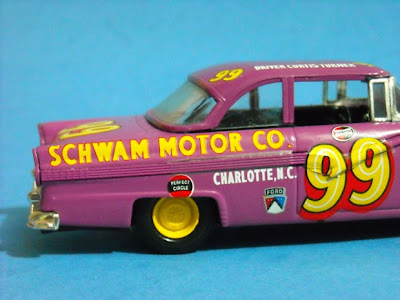From the net:
Curtis Turner was born in Floyd, Virginia and began his racing career in 1946 when he
finished 18th in a field of 18 contestants in a race at Mount Airy, North
Carolina. However, he rebounded and won his next race. During his career, he won
360 races in several different racing series, including 22 in the NASCAR
Convertible Division in 1956, and 17 wins in the NASCAR Grand National series
(now Sprint Cup). From 1950 to 1954, he drove for Oldsmobile being billed as the
Blond Blizzard of Virginia. He switched to driving Fords in 1954. He eventually
acquired the nickname of Pops, allegedly because of the way he would "pop" other
drivers on the track.
Turner's 1967 Daytona 500 racecarCurtis Turner (April 12, 1924 – October 4,
1970) was an early NASCAR driver. In addition to his success in racing, he made a fortune, lost it, and remade it buying and selling timberlands. Throughout his
life he developed a reputation for drinking and partying. In 1999, he was
inducted into the Virginia Sports Hall of Fame.
He is noted for several other racing accomplishments:
The only NASCAR driver to win two Grand National races in a row from the pole
by leading every lap (Rochester, New York and Charlotte, North Carolina in
July 1950)
The only win in NASCAR for Nash — Charlotte 150 — April 1, 1951
The only driver to win 25 major NASCAR races in one season driving the same
car in each of them (in 1956 — 22 were won as the #26 car in the convertible
division, the other three, including the 1956 Southern 500, were with a top
welded on.)
The only driver to win a major NASCAR race that was red-flagged because his
car was the only one still running (at the Asheville-Weaverville, North
Carolina track on September 30, 1956.)
The first driver to climb Pikes Peak in less than 15 minutes (in a 1962 Ralph
Moody Ford — the actual time was 14 minutes 37 seconds for the 14 mile
course.)
The first winner of the American 500 at Rockingham, North Carolina (in a 1965
Woods Brothers Ford.)
The first driver to qualify for a NASCAR Grand National race at a speed
greater than 180 miles per hour (1967 Daytona 500, driving #13, a 1967 Smokey
Yunick Chevrolet.)
Turner conceptualized, secured financing for, and built Charlotte Motor
Speedway in 1960 before being forced out by his business partners.
2006 inductee of the Motorsports Hall of Fame of America.
Being able to see the racing industry from the business end, he developed a
feeling that drivers deserved a better deal for their role in the sport. He attempted to organize a union for them in 1961. Unfortunately for him, NASCAR
has never looked favorably on an organized union for the drivers, and Turner was
banned for life. However, the ban was lifted in 1965, and he returned to racing.








































